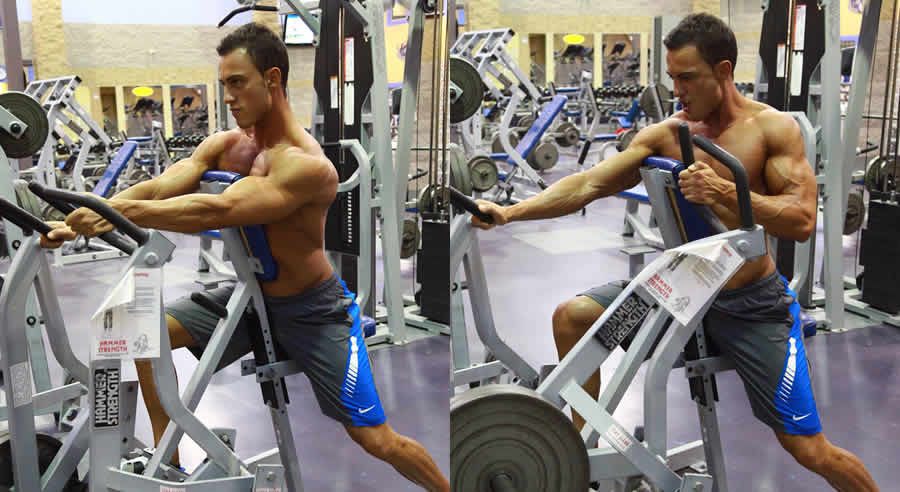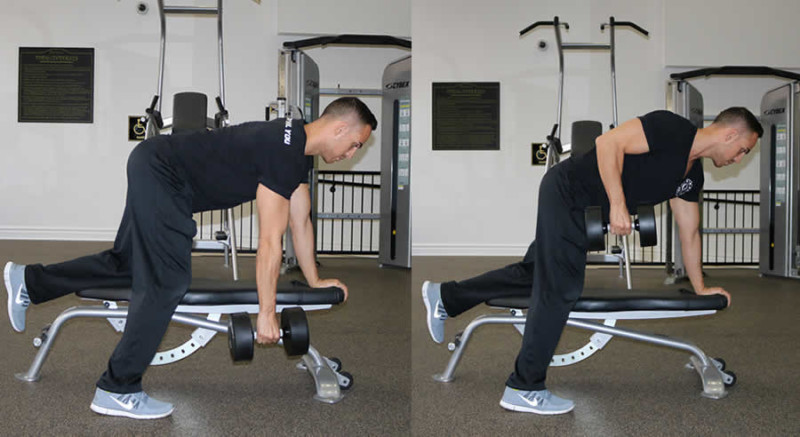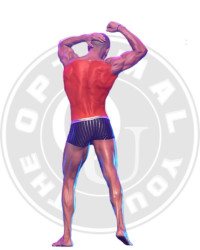Purpose of The Hammer Strength One-Arm Row
The Hammer Strength One-Arm Row is a machine based exercise designed to target the lats (latissimus dorsi), but can also be modified to place added emphasis on the rear deltoids, and rhomboid muscles.
Equipment Needed For Hammer Strength One-Arm Rows
As you can imagine, the name of this exercise is self-explanatory in that it can only be performed if your gym comes equipped with a hammer strength one arm row machine.
Difficulty of Hammer Strength One-Arm Rows
On a scale of 1 to 5, Hammer Strength One-Arm Rows would rank between a 2 and a 3, as the resistance is on a “track,” which allows you to put greater focus on mentally directing as much stress onto the lat as possible – which is generally one of the most difficult things for people to do when training the lats.
How to do Hammer Strength One-Arm Rows
To perform Hammer Strength One-Arm Rows, you’ll first need to adjust the height of the seat to the right height – a height that allows for a smooth, continuous contraction of the lat.
If the seat is too high, your hand will be too low when gripping the handle which will result in the motion looking more like a straight-arm pulldown variation, in which you’ll be limited in how much weight you can use due to reduced involvement from the biceps.
On the flip side, if the seat is too low, your hand will be too high when gripping the handle which will result in excessive elbow flexion taking place, increasing the demand on the biceps at the expense of the lat – the can also be a limiting factor in the amount of weight you can use.
When the seat is set at the correct height for your body’s dimensions, your forearm will be almost completely parallel with the floor, but feel free to raise, or lower seat as needed based on how the movement feels to you.
Once you’ve adjusted the height of the seat and grabbed onto the handle, use your opposite arm to stabilize your body, and pull the handle back, tight to your body, keeping your elbow tight to your body, preventing it from flaring outwards.
Hold the contraction for 1-2 seconds before slowly lowering the weight back to the starting position before performing the next repetition.
Key Points When Performing Hammer Strength One-Arm Rows
- Adjust the height of the seat to your body’s dimensions
- Use your opposite arm to stabilize your body
- Pull the handle towards your body, keeping your elbow tight to your body
- Squeeze the lat as hard as you can for 1-2 seconds before slowly lowering and transitioning into the next rep
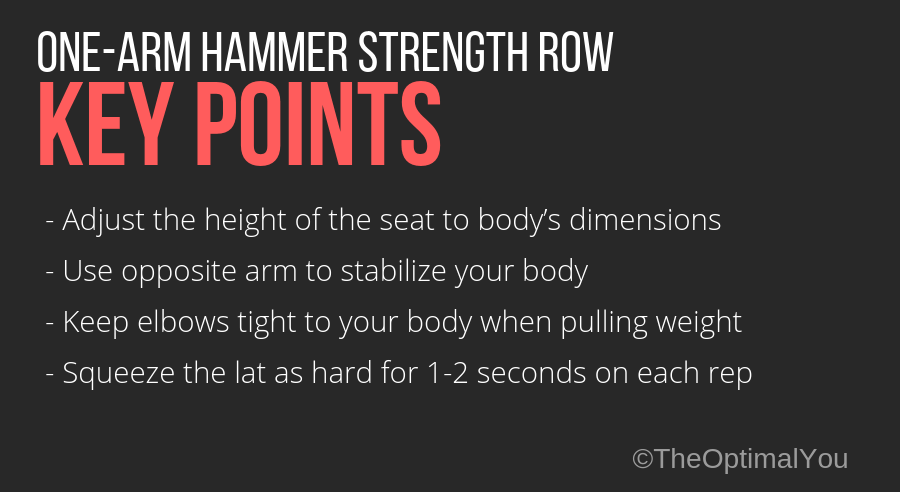
How Many Reps When Performing Hammer Strength One-Arm Rows
The ideal amount of reps to perform when performing the Hammer Strength One-Arm Row is dependent on your experience level. Because this machine is relatively safe, at least in comparison to other free-weight row variations, an advanced lifter can greatly benefit by loading this machine up and performing between 6-8 reps.
For those who are more beginner, or intermediate, it would be wiser to go relatively lighter, aiming for 10-12 reps, and focusing on contracting the desired muscles as hard as possible during your set. If you can’t contract the desired muscles effectively, it makes little sense to pile on the weight just for the sake of it.
Common Mistakes When Performing Hammer Strength One-Arm Rows
Some of the more common mistakes when performing overhand barbell rows are:
- Going too heavy – it can be tempting to pile on the weight when performing this exercise, simply because it’s a rather safe exercise, but if the weight is too heavy you can easily find yourself generating momentum to initiate the movement, reducing the demand on the desired muscles you wished to train when choosing the Hammer Strength One-Arm Row in the first place.
- Not adjusting the seat to the right height – as obvious as this may sound, a lot of people are either too lazy to take the time to set the height of the seat up, or might not know how, and thus they just leave it at the height the last person set it at. If the seat is not set at the appropriate height for YOU, then this exercise can end up tipping the scale in favor of greater risk, and less reward.
- Failing to control the weight – because this machine can be loaded up safely, a lot of people will misuse this machine by pulling much harder than is necessary, in an effort to lift more weight or do more reps. This results in the weight being lifted by muscles besides the lats, such as the biceps.
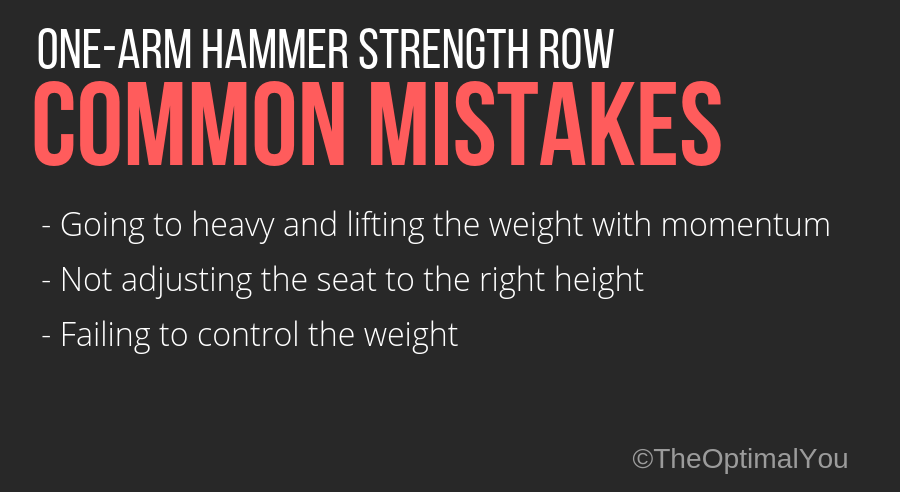
Modifications to The Hammer Strength One-Arm Rows
The reason it is suggested to keep the elbows tight to the body is because that is the plane of motion that the lats are most responsible for. If you wanted to target more of the mid-back (rhomboids, traps), or rear delts, then you could grab one of the handle that is further out away from the midline of the body, and flare your elbows out to the side as you row.
This facilitates a more effective flaring of the elbows, and puts the rear deltoids and rhomboids in more direct opposition of the resistance.
When To Do Hammer Strength One-Arm Rows
Hammer Strength One-Arm Rows are best suited towards the back end of a back workout, after you’ve done some free-weight movements – which you want to do early on, as they require more coordination, and the more fatigued you are the greater risk there is, so do those when you’re fresh.
Fatigue won’t negatively impact performance as much because of the increased stability provided when performing Hammer Strength One-Arm Rows, so they can even be placed last in the workout and still provide massive benefit.
Alternatives to Hammer Strength One-Arm Rows
The most resembling alternative to the Hammer Strength One-Arm Row would be a one-arm dumbbell row, so if your gym doesn’t have this piece of machinery, that would be your best alternative. Along with one-arm dumbbell rows, one-arm cable rows would also be a viable alternative.
Hammer Strength One-Arm Rows vs. One-Arm Dumbbell Rows
Hammer strength one-arm rows and one-arm dumbbell rows although similar, posses a few glaring differences.
For example, with the Hammer Strength One-Arm Row it’s a lot easier to stabilize yourself because you don’t have to oppose gravity (which is pulling you down toward the floor), and the resistance is on a “track.”
Whereas with the one-arm dumbbell row, you are in a bent-over position in which you have to stabilize yourself with your opposite hand, while also holding up your entire bodyweight. And because the weight is not on a “track,” it’s a lot easier for form to break down, which reduces the effectiveness of the exercise.
Image difference between Hammer Strength One-Arm Row using a machine and the One-Arm Dumbbell Rows exercise using a dumbell
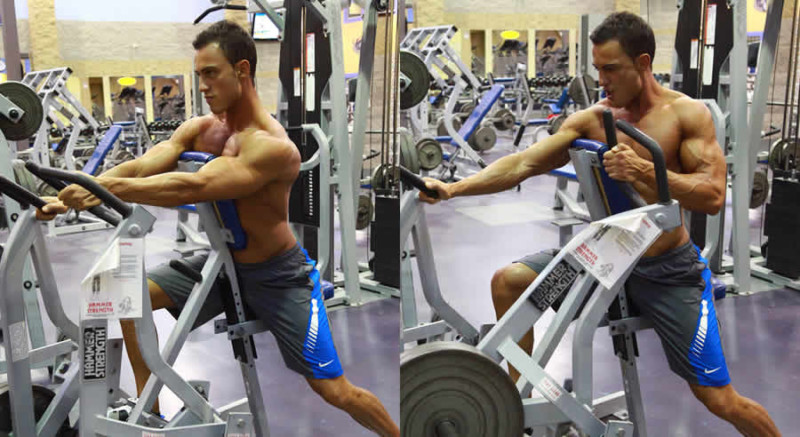
Hammer Strength One-Arm Row is a machine based exercise
[WPGP gif_id=”18798″ width=”600″]
Summary:
Primary Muscle: Back
Equipment: Machine
Level: Beginner
Purpose: To target the rhomboid muscle of your back.
Here’s The Next Step…
Are you ready to use the one of the routines from this post?
If so, then we recommend grabbing the free checklist we made just for this blog post.
The checklist takes you step by step to show you how to use all of the plans listed here…
…plus 2 bonus techniques that I didn’t have room for in today’s post.
Enter your name and email to access the checklist.
[content name=cta]

